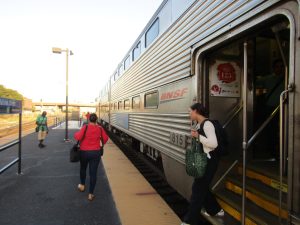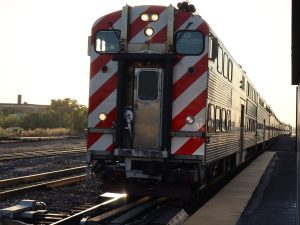CTA-Metra pass for UIC students beats expectations
By Igor Studenkov For Chronicle Media — October 9, 2024
Riders disembark at the BNSF Metra Line’s Halsted Street station, the closest station to the University of Illinois Chicago. (Photo by Igor Studenkov/for Chronicle Media)
A pilot program to expand CTA transit passes to Metra is off to a good start.
U-Pass is a CTA pass that gives students in participating colleges unlimited rides for an entire semester.
For the 2024-25 school year, University of Illinois Chicago is giving its students an option to buy a special U-Pass, known as U-Pass+, that works on Metra as well. If the pilot is successful, Metra is open to expanding the pass to other colleges.
U-Pass+ costs $349 during the fall and spring semesters, and $275 during the shorter summer semester. By comparison, the CTA-only U-Pass costs $163 during the fall and spring semesters and $125 during the summer semester. U-Pass+ represents savings compared to four Metra monthly passes, which can cost anywhere between $300 and $540 depending on the distance traveled and whether they travel to one of the Loop terminals.

The BNSF Line express train to Aurora heads past the Halsted Street station. (Photo by Igor Studenkov/for Chronicle Media)
The U-Pass program includes 65 colleges and universities that are either based in Chicago or have a campus in the city. Before the pandemic, students in the participating colleges got U-Passes automatically, with the cost included in their activity fees. When colleges went remote, the passes became something students could opt in for, an arrangement CTA decided to keep as the pandemic subsided.
While Pace has accepted U-Passes since Jan. 1, 2009, the pilot marks the first time Metra has accepted them.
UIC is one of the few Chicago area colleges that has Metra service. The BNSF Line’s Halsted station is near the edge of UIC’s South Campus. Many students take Metra from the suburbs and take CTA the rest of the way.
Brian Cousins, UIC’s interim associate vice chancellor for student affairs, told Chronicle Media that students have been asking about expanding the U-Pass to Metra for “several years.”
However, it wasn’t until Mohammed Haq, a Class of 2024 senior who served as student representative on the UIC Board of Trustees, that the push gained traction.
“He kind of championed that cause and wanted to do whatever he could to bring this forward,” Cousins said.
He said that the previous associate vice chancellor asked Cousins and Matt Miller, UIC’s IT director, to reach out to Metra and see if it was feasible.
“We weren’t too confident that they’d be interested, because we didn’t have the number, we didn’t have the hard data [on what the demand was],” Cousins said. “Honestly, we were shocked by their initial interest.”
Michael Gillis, agency spokesperson, said, “UIC came to us about a year ago and asked us if we could do something similar to what the CTA does. We worked with our colleagues at the CTA to see what was possible and together we came up with the pilot program.”
With workplace commuters no longer going to the Loop as regularly as before the pandemic, Metra has been trying to increase ridership by exploring other markets.

The BSNF Line train to Chicago approaches the Halsted Street station. (Photo by Igor Studenkov/for Chronicle Media)
The big stumbling block, Miller explained, is that the U-Pass program still requires students to get physical cards. Riders can normally only use Ventra on Metra if they have the app, but U-Pass cards originally couldn’t be linked to the app. It took a few months to work out the process.
Miller said that when the pilot kicked off, 150 students couldn’t get their U-Passes loaded onto the app. As of Oct. 2, that number is in single digits.
Miller said that UIC wants to shift away from physical cards, and he hopes that the pilot would help them achieve that goal.
“Students are looking for a digital lifestyle, they don’t like to rely on a physical card,” Miller said. “We do look forward to not having to have a [physical card] for the CTA component, and that puts us on that path.”
Miller said that 4,166 students, or roughly 12.6 percent of all U-Pass eligible students, signed up for the U-Pass+, while 12,110, or 36.7 percent of eligible students, signed up for the CTA-only U-Pass. Cousins said that it went beyond their optimistic expectations.
“Matt and I were thinking of 3,000 people signed up, that would be win — we got more than that,” he said, adding that he was “most happy” that this year saw the highest number of participants since the program switched to opt-in system.
The data Metra collected shows that students are using every single line in the system. As of Sept. 24, the agency recorded 84,039 U-Pass+ trips. The biggest portion of those riders, around 20 percent, used the BNSF Line. Metra executive director Jim Derwinski said that the Halsted station ridership “completely jumped.”
Milwaukee District West Line, which serves the West Sides of Chicago and much of west suburban Cook, DuPage and Kane counties, got the second-highest portion of riders, around 18.3 percent. Union Pacific Northwest Line, which serves McHenry County, northwest suburban Lake and Cook counties and Chicago’s Northwest Side, got the third-highest number, 13 percent.
Metra Electric, Chicago Rock Island and Southwest Service lines, which collectively serve much of Chicago’s South Side and south suburban Cook County, saw 4.4 percent, 8.8 percent and 8.8 percent, respectively. Milwaukee District North Line, which serves other parts of the Northwest Side and northern Cook County and Lake County suburbs, got 9 percent of the riders.
Union Pacific West Line, which serves west suburban Cook, DuPage and Kane counties, got 8.8 percent of the riders. Union Pacific North Line, which primarily serves North Shore suburbs and Chicago’s North Side, got 5 percent. North Central Service Line, which mostly serves Lake County and a few parts of Cook County, got 3 percent. Heritage Corridor, the rush hour only line, got less than 1 percent.
During the Sept. 18 Metra Board of Directors meeting, it was reported the first few weeks of the pilot as “an incredible start for this partnership.”
The directors expressed support for the pilot, suggesting University of Chicago, which is directly served by Metra Electric Line and already offers U-Passes, and Loyola University, which offers U-Passes, but doesn’t get any direct Metra service, as candidates for pilot expansion. Director Kenneth Koehler, who represents McHenry County, suggested that there is plenty of opportunities to capture students who are commuting to Chicago universities from the suburbs via some combination of Metra and the ‘L’.
“We’re not helping all of these students,” he said. “This program needs to expand to everybody that we can expand it to in the very near future,”
Aside from University of Chicago. Metra Electric provides direct service to Chicago State University. There are also opportunities to provide service to colleges that don’t offer U-Passes, but are in the CTA service area. Union Pacific North Line’s Davis Street station is within walking distance of Northwestern University’s Evanston campus.
Metra also serves several colleges outside CTA service area. Union Pacific West’s College Avenue station is located next to Wheaton College’s main campus, and Lake Forest College is within walking distance of Union Pacific North’s Lake Forest station, and College of Lake County is next to the line’s Waukegan station.
Gillis told Chronicle Media that any discussions about expanding the pilot are premature.
“We have had conversations with other interested schools, but we will not be expanding the program until this pilot is far enough along for us to assess the results, including the costs of extending it and whether it would be financially sustainable,” he said.







